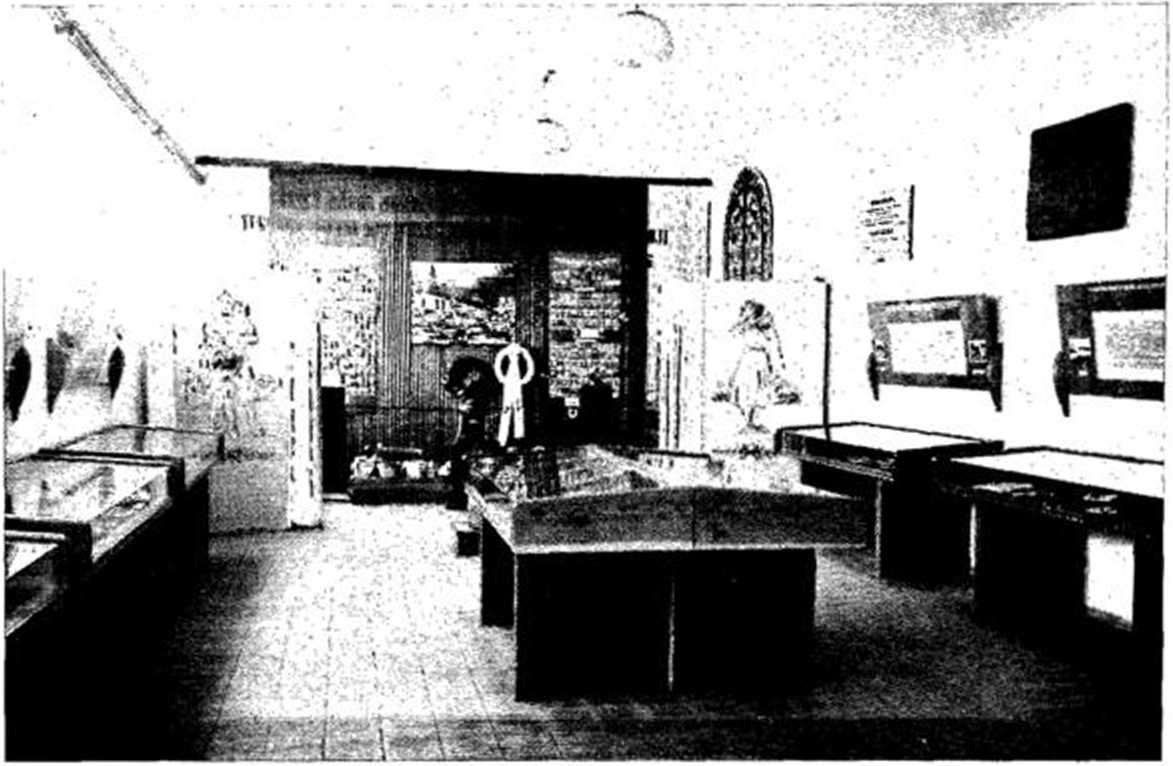3416400754

8. Krajskź Museum v Olomouci. Reunion d’une societe d’amatcurs des arts populaires au Musec regional d’01omouc. La region d’OIo-mouc comptc cn tout 18 musees, qui ont orga-nisć cn 1956 41 espositions et 21 \ conferenccs; 27 socićtes cPhistoirc et gćographie du terroir travaillcnt en coliaboration avec cux.
8. Mceting of members of a Folk Arts Society in the Olomouc Regional Museum. The Olomouc region has a total of 18 museums which organized 41 cwhibitions and 211 lcc-tures in 1956. They are assisted in their work by 27 local history and geography societies.
The large national museums also assist the local ones in putting on new displays. The National Museum at Prague gave effective help in organizing a display at Ćesky Krumlov, while the Museum of National Literaturę co-operated in organizing commemorative exhibitions of the work of leading figures and transforming the houses where they were born into museums. Among those thus commemorated were K. H. Borovsky (museum inHavlićkuv Bród), the poct Konstantin Biebl, and the celebrated Czech pedagogue, J. A. Komensky3 (museum in Fulnek). In 1955, the Czech Goyernment, after making a study of the work done by the national museums, decided to treat it on a par with that done by the scientific research centrcs, which meant that the museums were placed on the same footing as the various institutes of the CzechosIovak Academy of Sciences. This measure reflected a correct eyąluation of the part played by museums in promoting scientific work.
A special feature of Czechoslovak museography is the large number of generał museums with collections dealing with a limited area: the homeland museums.2 Their essential role is to present documentation and display objects illustrating the natural environment, the social development and the products of human activity in the limited arca in question. They are administered by the Regional District and Local Committees. There are 415 of them in Czechoslovakia, mainly concentrated in Bohemia and Moravia and a few in Slovakia. The regional ones have large collections, sometimes comprising tens of thousands of objects. Among the largest homeland museums are the regional ones in Plzeft, Liberec (fig. 6, 7), Olomouc (fig. (?) and Hradec Krdlovć and the district ones in Klato vy, Prostejov, Znojmo, Kolin, Chrudim, etc.
These regional and local museums are at present concentrating on organizing displays, and new exhibition rooms have reccntly becn fitted out and opencd to the public by museums in Pardubice, Presov, Rożnava, Gottwaldov, Ćesky Krumlov, Susice, Valasskć Mezirici, Dećln, Vsetin, Vyskov and elsewherc. This alonc is an indication of how, on the basis of scientific research, Czechoslovak museums are constantly intensifying their work of popularization.
These museums employ only smali staffs—10 to 25 for regional museums and 1 to 5 for district ones, but groups of laymen interested in museum work are attached to them and give very effective unpaid help in assessing materiał, arranging displays and installing new exhibitions. It was a group of yoluntary workers of this kind, for example, which organized the Vyśkov Museum exhibition.
In addition to the exhibitions (fig. 9) organized by the homeland museums,2 not a year goes by without seyeral of the great men of Czech history and culture being commemorated by museums installed in the houses where they were born, or by exhibitions staged in memoriał halls. Among those recently honoured in the former manner were the historian F. Palack^, and the late Presidcnt of the Republic, Klement Gottwald; exhibitions were organized in memory of the playwright
9. V onci Lidtce u Prahy. Musće commćmo-ratif cree sur le territoirc de la communc dc Lidice, pres dc Prague, rasće sous 1’occupation nazie.
9. Memoriał museum established in the Com-mune of Lidice, near Prague, which was razed to the ground during the Nazi occupation.
3. Sec also: Josef Benes, “The Comenius Museum, Uhersky Brod’\ Museum, vol. X (1957), p. 161-163.

86
Wyszukiwarka
Podobne podstrony:
TARIFS D’ AB ONNEMENTpour 3 numćros par an, dont un double Abonnement du ler/08/93 au 31/07/94 Fr
632 UN DEBAT : LES MENTAUTES COLLECTIYES 2 arts majeurs: l’architecture, la sciilpture, la pein
2.1 Le contenu de 1’interdiction de harcelement psychologique Un des elements essentiels au niveau d
page0101 99 vous serve de guide, et que vous entriez dans un pays ou coulent des ruiśseaux de lait e
puis se reduisent a un cordon rivulaire large de quelques metres au dęła du km 20. Les especes renco
L/Educateur Prolźtarien 315Pour un Naturisme ProletarienLa Thśorie des Globules blancs 12)
160 recouvrement judiciaire, en cas tfimpayś, est un draft8.99 Si Ton se fie au statut corrcemant le
un fosse a une distauce de 12 m. des constructions situóes au soramet du rocher. Une palissade dont
632 UN DEBAT : LES MENTAUTES COLLECTIYES 2 arts majeurs: l’architecture, la sciilpture, la pein
158 Societe des Nations — Recueil des Traites. 1933PROTOCOLE Au moment de la signature de TAcco
important, car Cuda couvre ainsi un large marche avec des produits tres simples d installation : des
IElEVISIOIiLa tele prend un air de fete Daniele L. Gauthier Tout au long dc la *cmainc. Ic* ćmiuion*
95 (35) EXERCICES DE VOCABULAIRE Q Placez sous le bon dessin les expressions suivantes: un litre de
38 Arctiąue represente un vrai defi. Ainsi des etudes scientifiąues demontrent que les petroliers tr
sens et confćrant un cachet sensiblement plus primitif a la population de Saint-Agnan, ne nous ont p
A qui ? A un Parlement supranational ? Non, a des membres d’executifs nationaux. Non, il faut que&nb
więcej podobnych podstron